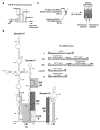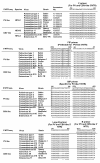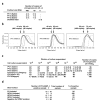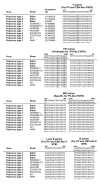Development of a reverse transcription-loop-mediated isothermal amplification (RT-LAMP) system for a highly sensitive detection of enterovirus in the stool samples of acute flaccid paralysis cases
- PMID: 20015403
- PMCID: PMC2803793
- DOI: 10.1186/1471-2334-9-208
Development of a reverse transcription-loop-mediated isothermal amplification (RT-LAMP) system for a highly sensitive detection of enterovirus in the stool samples of acute flaccid paralysis cases
Abstract
Background: In the global eradication program for poliomyelitis, the laboratory diagnosis plays a critical role by isolating poliovirus (PV) from the stool samples of acute flaccid paralysis (AFP) cases. In this study, we developed a reverse transcription-loop-mediated isothermal amplification (RT-LAMP) system for a rapid and highly sensitive detection of enterovirus including PV to identify stool samples positive for enterovirus including PV.
Methods: A primer set was designed for RT-LAMP to detect enterovirus preferably those with PV-like 5'NTRs of the viral genome. The sensitivity of RT-LAMP system was evaluated with prototype strains of enterovirus. Detection of enterovirus from stool extracts was examined by using RT-LAMP system.
Results: We detected at least 400 copies of the viral genomes of PV(Sabin) strains within 90 min by RT-LAMP with the primer set. This RT-LAMP system showed a preference for Human enterovirus species C (HEV-C) strains including PV, but exhibited less sensitivity to the prototype strains of HEV-A and HEV-B (detection limits of 7,400 to 28,000 copies). Stool extracts, from which PV, HEV-C, or HEV-A was isolated in the cell culture system, were mostly positive by RT-LAMP method (positive rates of 15/16 (= 94%), 13/14 (= 93%), and 4/4 (= 100%), respectively). The positive rate of this RT-LAMP system for stool extracts from which HEV-B was isolated was lower than that of HEV-C (positive rate of 11/21 (= 52%)). In the stool samples, which were negative for enterovirus isolation by the cell culture system, we found that two samples were positive for RT-LAMP (positive rates of 2/38 (= 5.3%)). In these samples, enterovirus 96 was identified by sequence analysis utilizing a seminested PCR system.
Conclusions: RT-LAMP system developed in this study showed a high sensitivity comparable to that of the cell culture system for the detection of PV, HEV-A, and HEV-C, but less sensitivity to HEV-B. This RT-LAMP system would be useful for the direct detection of enterovirus from the stool extracts.
Figures





Similar articles
-
Development of an efficient entire-capsid-coding-region amplification method for direct detection of poliovirus from stool extracts.J Clin Microbiol. 2015 Jan;53(1):73-8. doi: 10.1128/JCM.02384-14. Epub 2014 Oct 22. J Clin Microbiol. 2015. PMID: 25339406 Free PMC article.
-
Culture-Independent Detection of Poliovirus in Stool Samples by Direct RNA Extraction.Microbiol Spectr. 2021 Dec 22;9(3):e0066821. doi: 10.1128/Spectrum.00668-21. Epub 2021 Nov 10. Microbiol Spectr. 2021. PMID: 34756088 Free PMC article.
-
Development of a One Step Reverse Transcription-Loop-Mediated Isothermal Amplification System for a Highly Sensitive Detection of Rabbit Hepatitis E Virus.Clin Lab. 2017 May 1;63(5):901-905. doi: 10.7754/Clin.Lab.2017.160919. Clin Lab. 2017. PMID: 28627822
-
Detection of human Enterovirus 71 reverse transcription loop-mediated isothermal amplification (RT-LAMP).Lett Appl Microbiol. 2012 Mar;54(3):233-9. doi: 10.1111/j.1472-765X.2011.03198.x. Epub 2012 Jan 18. Lett Appl Microbiol. 2012. PMID: 22256968
-
Improvement of a real-time RT-PCR assay for the detection of enterovirus RNA.Virol J. 2009 Jul 7;6:95. doi: 10.1186/1743-422X-6-95. Virol J. 2009. PMID: 19583870 Free PMC article. Review.
Cited by
-
Rapid detection of wheat yellow mosaic virus by reverse transcription loop-mediated isothermal amplification.Virol J. 2011 Dec 20;8:550. doi: 10.1186/1743-422X-8-550. Virol J. 2011. PMID: 22185375 Free PMC article.
-
Development of an efficient entire-capsid-coding-region amplification method for direct detection of poliovirus from stool extracts.J Clin Microbiol. 2015 Jan;53(1):73-8. doi: 10.1128/JCM.02384-14. Epub 2014 Oct 22. J Clin Microbiol. 2015. PMID: 25339406 Free PMC article.
-
Rapid Detection of Lily mottle virus and Arabis mosaic virus Infecting Lily (Lilium spp.) Using Reverse Transcription Loop-Mediated Isothermal Amplification.Plant Pathol J. 2020 Apr 1;36(2):170-178. doi: 10.5423/PPJ.OA.04.2019.0096. Plant Pathol J. 2020. PMID: 32296296 Free PMC article.
-
Development of Loop-Mediated Isothermal Amplification (LAMP) for Universal Detection of Enteroviruses.Indian J Microbiol. 2014 Mar;54(1):80-6. doi: 10.1007/s12088-013-0399-7. Epub 2013 Apr 2. Indian J Microbiol. 2014. PMID: 24426171 Free PMC article.
-
Development of a reverse transcription loop-mediated isothermal amplification assay (RT-LAMP) that detects enteroviruses by targeting the highly conserved 5'-UTR region.Virus Genes. 2020 Apr;56(2):194-201. doi: 10.1007/s11262-020-01732-w. Epub 2020 Jan 18. Virus Genes. 2020. PMID: 31955385
References
-
- World Health Organization. Polio Laboratory Manual WHO/IVB/0410 and Supplement to the WHO Polio Laboratory Manual, World Health Organization. 4 2004.
-
- Rueckert RR. In: Fields virology. 3. Fields BN, Knipe DM, Howley PM, editor. Vol. 1. Lippincott-Raven, Philadelphia, PA; 1996. Picornaviridae: the viruses and their replication; pp. 609–654.
Publication types
MeSH terms
Substances
LinkOut - more resources
Full Text Sources
Medical

